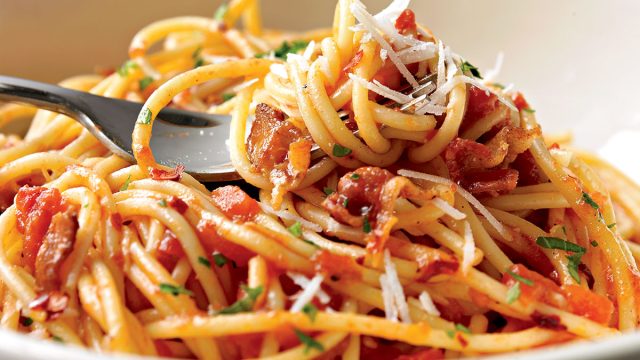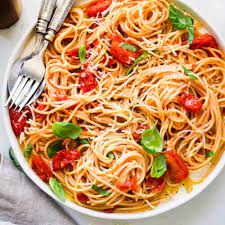Spaghetti is a delicious, long thin pasta, and also one of the most popular Italian cuisine. However Italian spaghetti is typically made from durum wheat semolina but mostly made of milled wheat, water and also enriched with vitamins and minerals.
This kind of pasta has a white color because of the inclusion of refined flour during the production process.
Brief History of Spaghetti
Consumption of spaghetti dates back to the 5th century AD, from Talmud, the pasta then referred to dried pasta that could be cooked through boiling, same as that of today’s kinds of pasta.
However, the popularity of spaghetti spread throughout Italy after the establishment of spaghetti factories in the 19th century, enabling the mass production of spaghetti for the Italian market, also in the 19th century, spaghetti was offered in restaurants as spaghetti Italienne.
Production of Spaghetti
Fresh spaghetti: This kind of pasta is being prepared using a pasta machine, at its simplest, imitation spaghetti can be formed using no more than a rolling pin and a knife. A home pasta machine simplifies the rolling and makes the cutting more uniform.
But of course, cutting sheets produces pasta with a rectangular rather than a cylindrical cross-section and the result is a variant of fettuccine. Some pasta machines have a spaghetti attachment with circular holes that extrude spaghetti or shaped rollers that form cylindrical noodles.
Read Also: Top 9 Foods & Drinks That Can Be Inflammatory
Spaghetti can be made by hand by manually rolling a ball of dough on a surface to make a long sausage shape. The ends of the sausage are pulled apart to make a long thin sausage. The ends are brought together and the loop is pulled to make two long sausages.
The process is repeated until the pasta is sufficiently thin. The pasta knobs at each end are cut off leaving many strands which may be hung up to dry.
Fresh spaghetti would normally be cooked within hours of being formed. Commercial versions of fresh spaghetti are manufactured.
Dried spaghetti
The bulk of dried spaghetti is produced in factories using auger extruders. While essentially simple, the process requires attention to detail to ensure that the mixing and kneading of the ingredients produces a homogeneous mix, without air bubbles.
The forming dies have to be water-cooled to prevent spoiling of the pasta by overheating. The drying of the newly formed spaghetti has to be carefully controlled to prevent strands from sticking together and to leave it with sufficient moisture so that it is not too brittle. Packaging for protection and display has developed from paper wrapping to plastic bags and boxes.
Dried spaghetti measured with a “spaghetti measure”. One portion of dried pasta weighs 120 grams, twice the amount of one serving on the package the measure can portion out 1, 2, 3, or 4 servings based on the diameter of the circle.
Preparation
Spaghetti can be cooked in a variety of different ways, below are a few tips that will guide you on how to cook spaghetti.
Read Also: The 12 Best Foods and Drinks that are Good for the Liver
Cooking materials:
Spaghetti tong
Spaghetti scop
Large pot (for cooking)
Big filter basket for draining
(i) First and foremost, we start by putting on our gas, and a pot of water with which we are going to use to cook the spaghetti.
(ii) Wait for like 2-3minutes for the water to get warm, then put the pasta inside the warm/boiled water and wait for another 3-5minutes.
(iii) During the waiting period ensure to use a cooking spoon to turn the spaghetti so it absorbs water, after this drain the spaghetti pasta inside a rubber filter basket.
(iv) You can then serve, with your favorite dish.
Spaghetti Cuisines
Spaghetti pasta can be served in two different ways;
(i) Italian cuisine
(ii) International cuisine
Read Also: Foods that fight inflammation (Anti inflammatory Foods)
Italian cuisine
Classic Spaghetti alla carbonara: This is an Italian pasta cuisine, which is mostly and frequently served on special occasions.
Also, it is an emblem of Italian cuisine, spaghetti is frequently served with tomato sauce, which may contain various herbs, olive oil, meat, or vegetables.
International cuisine
Spaghetti bolognese, very common outside of Italy, but not customary in that country
In some countries, spaghetti is sold in cans/tins with sauce.
Is Spaghetti Bad For My Health?

Spaghetti is a high carbohydrate food, and your body needs carbohydrates for energy, spaghetti pasta is a good choice for does seeking a balanced carbohydrate diet.
Nutrition Facts
Spaghetti pasta contains numerous minerals and vitamins, some of which include; Calories, sodium, fat, fiber, protein, sugar, and carbohydrate.
Read Also: Mexican Spices – Complete Guide to Spike Up your Meals
Health Benefits
The major reason why spaghetti pasta is better for you is that it contains more fiber than regular pasta.
As mentioned earlier, it is a high carbohydrate food, which makes it an energy-giving food. Fiber is essential for a healthy digestive system.
Allergies and Interaction
Spaghetti pasta is made from wheat, and this wheat contains the protein gluten. However, gluten is one of the top food allergies for adults and children, people with celiac disease condition need to avoid gluten entirely.
Symptoms of celiac disease include; Vomiting, abdominal bloating, gas, and nausea, some people also get rashes and headaches from eating wheat.
Read Also: Used Cooking Oil Recycling Process: Complete Guide
Was this article helpful? Please share your thoughts and opinions in the comments section below.
